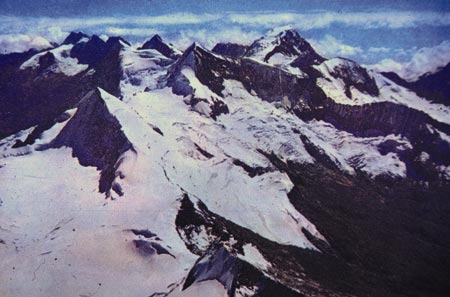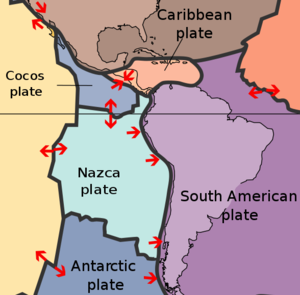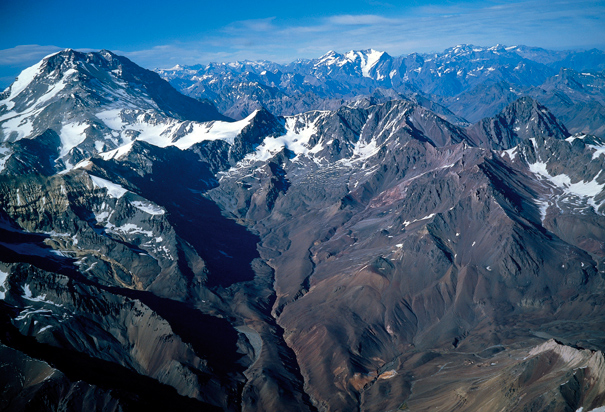Andean Region, Colombia
 | |
| The Andean Region made up of Cordillera Occidental, Cordillera Central, and Cordillera Oriental. |
Creation of the Andean Region landscape:
The Cordillera Occidental, Cordillera Central, and
Cordillera Oriental comprise the Andean region in Colombia and were formed
through the convergent (subduction) process. The area originated in the
Paleozoic ear when the Nazca tectonic plate collapsed with the South American
plate. The Cordilleras are a product of different formation processes and are
shaped through the river valleys that divide the peaks from one another. The
Andes in Colombia will continue to experience orogenic events because the Nazca
Plate, moving at 3.7cm/ year, is still sliding beneath the South American Plate.
The subduction is also producing minor to major earthquakes and volcanic activity.
The Andean Region in 1,000 years:
In 1,000 years the Nazca plate will have moved 37 meters
under the South American plate, which will move the three Cordillera Mountain
ranges to the east. One thing to remember is that the Galeras, a stratovolcano,
in addition to many other volcanoes, is on the fault line. Plate movements can
possible cause eruption, which can cause not only biotic destruction, but a
climate change as well. Multiple
volcanic eruptions will cause cooler temperatures in Colombia. This particular
type of volcano can inject large amounts of particulate, of which includes
sulfur dioxide and carbon dioxide gas where it combines with water in the
stratosphere to form sulfuric acid. Solar radiation cannot penetrate aerosols
and volcanic particulate in the atmosphere, lowering Earth’s temperature. In
addition to volcanic activity, plate movement will cause multiple earthquakes,
which will be deeper and longer because of continual plate collision.
 |
| With the increased amount of plate movements, there will be not only multiple volcanic eruptions but also the formation of mountains. |
Assuming the Nazca plate keeps moving at the current rate,
by 10,000 years it would already have moved a total of 370m into the South
American plate. This subduction zone will continue to push the Cordilleras
east, while creating volcanoes and earthquakes and another mountain range.
Similarly, with the increasing volcanism that causes decreases in regional and
global temperatures, Colombia’s climate may change from a fluvial landscape to
a glacial and temperate landscape. The cooling temperatures will activate
alpine glaciation in the Cordilleras (south of Colombia) while northern
Colombia will have a cooler climate. The area will experience massive
landslides as volcanic eruptions heat the glaciers and cause major lahar/debris
flow.
The Andean Region in 1,000,000 years:
In 1 million years, assuming the Earth is in a glacial age
as result of violent volcanism, the
Andean region will look different than today. The Nazca Plate would have
already moved 37 kilometers under the South American plate, wedging the
Galapagos Archipelago into the Colombian coast. The two river valleys between
the Cordilleras will have most likely turned to ice and there will be a col
landform where the ice from the mountain range fell. The rest of the landscape will be carved out
by the glacier plucking and carving, resulting in u-shaped valleys.
Conclusion:
The Andean region in Colombia will change over the next thousand, ten thousand, and one million years. Different geographical processes will cause the formation of mountains, as well as an increase in volcanism, earthquakes, and erosion.
References:
http://www.infoplease.com/ipa/A0107419.html
http://whatonearth.olehnielsen.dk/nazca.asp
http://earthquake.usgs.gov/earthquakes/eqarchives/poster/regions/nazca.php
http://clasfaculty.ucdenver.edu/callen/1202/Battle/Build/PlateTectonics/PlateTectonics.html
http://clasfaculty.ucdenver.edu/callen/1202/Battle/Build/VolcanicIn/Intrusive.html
https://www.google.com/search?q=colombia+geography&oe=utf-8&aq=t&rls=org.mozilla:en-US:official&client=firefox-a&um=1&ie=UTF-8&hl=en&tbm=isch&source=og&sa=N&tab=wi&ei=OSLBUPi1CMLY2gX9xYHoBA&biw=1280&bih=917&sei=OiLBUOb3MYe72QX0lIDoDA
http://www.google.com/imgres?um=1&hl=en&client=firefox-a&tbo=d&rls=org.mozilla:en-US:official&biw=1280&bih=917&tbm=isch&tbnid=E0k3lLfV6tJ42M:&imgrefurl=http://eyesoncolombia.wordpress.com/2009/09/05/how-the-andes/&docid=39QmelhtFAq0yM&imgurl=http://upload.wikimedia.org/wikipedia/commons/3/3b/Colombia_Topography.png&w=1839&h=2399&ei=oyLBUInxNsL62gWEpIG4Cg&zoom=1&iact=rc&dur=430&sig=111286461184354537651&page=1&tbnh=151&tbnw=116&start=0&ndsp=34&ved=1t:429,r:0,s:0,i:84&tx=96&ty=57
















